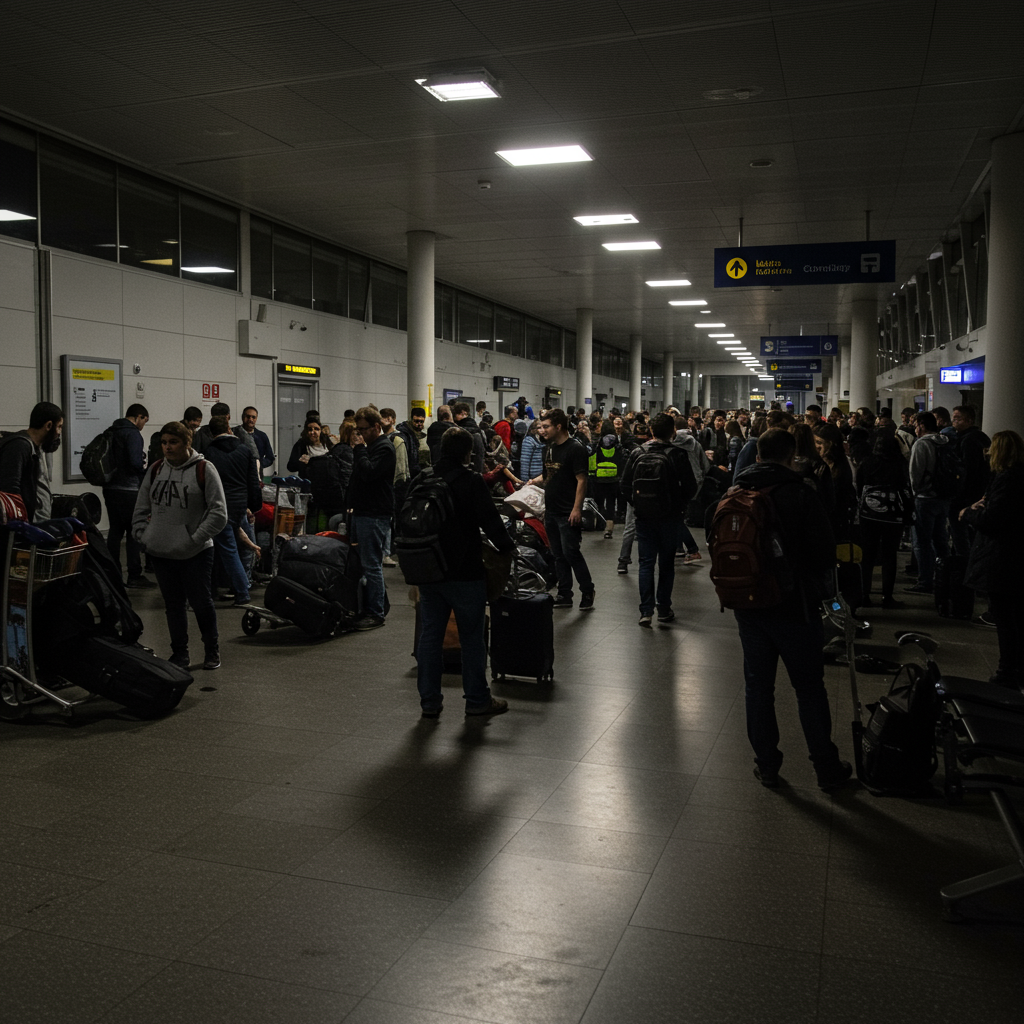London’s heathrow Airport, a vital global travel hub, was recently paralyzed by a devastating power outage. This incident led to widespread chaos, grounding flights and stranding countless passengers worldwide. While the disruption was immediate, investigations reveal its root cause was anything but sudden.
A comprehensive report paints a stark picture: the catastrophic failure stemmed from an electrical fault identified years prior and shockingly left unaddressed. This revelation raises urgent questions not only about the reliability of critical infrastructure but also about accountability and foresight in maintaining systems essential to national function.
What Happened During the Heathrow Airport Shutdown?
On March 20, a fire erupted at the North Hyde electrical substation. This facility is crucial, as it supplies power to a significant portion of Heathrow Airport. The resulting blaze triggered an immediate and extensive power cut, forcing one of the world’s busiest airports into a complete shutdown.
The consequences were immediate and severe, impacting roughly 270,000 passenger journeys. Thousands of flights were cancelled or significantly delayed. This disruption caused immense frustration and chaos for travellers.
The power failure’s impact extended well beyond the airport terminals. Essential public services and critical infrastructure reliant on the same power feeder were also affected. This included notable disruption to local road and rail transport networks. Hillingdon Hospital experienced power issues, underscoring the widespread critical nature of the outage. Furthermore, businesses and thousands of homes in the surrounding areas lost power, with some residents requiring evacuation. The financial cost was substantial, with airlines operating out of Heathrow estimating losses between £80 million and £100 million due to the forced closure and subsequent operational disruption. Power was partially restored to Heathrow the following day, but critical systems took several more hours, with flights only resuming late on March 21 after safety checks.
The Alarming Cause: An Ignored Warning
The recent investigation by the National Energy System Operator (NESO) has detailed the precise reasons behind the substation fire and subsequent power cut. According to the rigorous 77-page report, the fire was “most likely” caused by moisture infiltration into key electrical components. The primary issue originated within a high-voltage “bushing” situated on one of the substation’s vital transformers.
What is most concerning is that this specific problem was not a recent discovery. Elevated moisture readings within oil samples from this exact bushing were initially detected as far back as July 2018. Under National Grid’s own established guidance at the time, such readings explicitly indicated “an imminent fault.” The guidance clearly recommended that the affected bushing “should be replaced” without delay.
However, despite this clear warning seven years prior, the critical issue remained completely “unaddressed.” The NESO report meticulously documented “numerous opportunities” where necessary repairs or preventative maintenance could, and should, have been performed. Basic maintenance planned for 2022 that could have potentially mitigated the risk was “deferred.” Even more alarmingly, a 2022 review reportedly found fire suppression systems at the substation were “inoperable.” A fire risk assessment in July 2023 identified that a transformer fire “would not be suitably suppressed,” raising a “high priority” action that remained outstanding at the time of the March incident. The report painted a disturbing picture of “missed opportunities” and fundamental failures in the controls designed to ensure identified risks were acted upon promptly and effectively. Forensic analysis from National Grid and the London Fire Brigade confirmed the fire was caused by the catastrophic failure of the bushing components, with moisture leading to arcing electricity that ignited the transformer oil.
Who is Accountable and Regulatory Response
The North Hyde substation is owned and operated by National Grid, making them responsible for its maintenance and safety. While the NESO report aimed not to “apportion blame” directly, its findings undeniably point to National Grid’s failure to address the long-standing fault. NESO Chief Executive Fintan Slye emphasized that National Grid was solely responsible for maintaining the equipment and ensuring it was fit for operation. He stated that the faulty transformer should have been taken out of service for repair when the moisture was first identified in 2018. This critical failure to act allowed the problem to worsen over time, directly leading to the devastating fire.
The damning findings of the NESO report have prompted swift regulatory action. Energy watchdog Ofgem has wasted no time in launching an official enforcement investigation into National Grid. Ofgem will assess “any possible licence breaches” concerning the development and maintenance of the North Hyde substation, which dates back to the 1960s. Ofgem’s director general for infrastructure, Akshay Kaul, stressed the regulator’s clear expectation that energy companies “properly maintain their equipment and networks” to prevent such incidents. He issued a firm warning that Ofgem “will take action and hold companies fully to account” if evidence of negligence is found. Energy Secretary Ed Miliband publicly described the report’s findings as “deeply concerning,” particularly highlighting that “known risks were not addressed by the National Grid Electricity Transmission.”
In response to the scrutiny, National Grid stated it has a “comprehensive asset inspection and maintenance programme” in place. They added that they have “taken further action since the fire,” including reviewing oil sampling processes, enhancing fire risk assessments, and “re-testing the resilience of substations that serve strategic infrastructure.” National Grid pledged full cooperation with Ofgem’s investigation. However, the detailed findings within the report regarding years of deferred maintenance and unaddressed warnings significantly challenge the effectiveness of their prior maintenance practices. Ofgem has also commissioned an independent audit of National Grid’s critical infrastructure assets to determine if these “failings identified in Neso’s report … were a one-off in nature, or more systemic across the National Grid estate.”
Broader Implications for UK Infrastructure Resilience
The Heathrow power cut, while originating from a specific substation fault, has ignited a crucial national debate about the overall resilience of the UK’s Critical National Infrastructure (CNI). The incident exposed systemic vulnerabilities that extend far beyond airport operations and energy supply. A significant and troubling finding from the NESO review was a fundamental lack of awareness across the energy sector. Energy network operators, including National Grid, are reportedly “not generally aware” if the customers connected to their networks are designated as CNI. This means they may not fully appreciate the catastrophic downstream effects of a power failure on vital services like major hospitals, transport hubs, or government facilities.
Shockingly, the report noted it was “not known to the energy companies” that losing just one of Heathrow’s three electrical supply points would lead to an outage affecting the airport’s critical systems. This highlights a severe gap in understanding the specific power needs and vulnerabilities of major customers. The report also pointed to a “potential missed opportunity” for Heathrow itself to maximize its own internal energy resilience measures. While some nearby facilities, like data centres, successfully relied on backup generators, parts of the airport’s vital systems failed, requiring hours to restore.
Furthermore, the NESO review suggested there is currently “no explicit cross-sector requirement on CNI operators” to ensure they have appropriate plans and systems for continuity of operations in response to power disruption. This suggests a potential regulatory gap where vital infrastructure across different sectors may not be adequately mandated or incentivized to build sufficient resilience against foreseeable events like prolonged power outages. The incident serves as a critical wake-up call, demanding a comprehensive nationwide reassessment of how vital services are identified, protected, and made resilient against failures originating in interconnected infrastructure networks.
Heathrow Airport’s Response
Heathrow Airport itself reacted strongly to the NESO report’s findings. While welcoming the report for shedding light on the external power supply failure, the airport placed significant blame on multiple factors. It critically attributed the “catastrophic power outage” to a combination of “outdated regulation,” “inadequate safety mechanisms,” and, fundamentally, “National Grid’s failure to maintain its infrastructure.” Heathrow stated its clear expectation that National Grid will meticulously consider and implement robust steps to ensure such a disruptive and costly event is never repeated.
The severe operational and financial impact on the airport and its airline partners was a central theme. As Nigel Wicking, chief executive of the Heathrow Airline Operators’ Committee, confirmed, the closure cost airlines an estimated £80 million to £100 million. This substantial figure underscores the severe economic repercussions that cascaded directly from the infrastructure failure at the North Hyde substation. While power was ultimately restored and flights resumed, the incident highlighted the fragile dependency of complex operations like a major international airport on the reliability of external utility providers.
Frequently Asked Questions
What specific fault caused the power cut that shut down Heathrow Airport?
A detailed report by the National Energy System Operator (NESO) concluded the power cut and subsequent airport shutdown were most likely caused by moisture entering a high-voltage “bushing” on a transformer at the North Hyde substation. This moisture infiltration led to a short circuit and fire. Crucially, elevated moisture levels in this component were first detected seven years ago, in July 2018, indicating an “imminent fault” according to National Grid’s own guidance, but the required maintenance was repeatedly deferred.
What actions are being taken following the report on the Heathrow power cut?
Following the NESO report, energy regulator Ofgem has launched an official enforcement investigation into National Grid to examine potential license breaches related to the substation’s maintenance. Energy Secretary Ed Miliband has called the findings “deeply concerning” and stated the government will urgently consider the recommendations. National Grid claims it has a comprehensive maintenance program and has taken action since the fire, including reviewing processes and re-testing strategic substations, and is cooperating with Ofgem’s investigation.
Why is the Heathrow power outage raising concerns about UK infrastructure resilience?
The incident highlighted systemic issues in the UK’s Critical National Infrastructure (CNI). The NESO report revealed that energy network operators often lack awareness if customers are CNI and were unaware losing one supply point would disable critical airport systems. This exposes a gap in cross-sector planning and communication regarding vital infrastructure dependencies. It suggests a need for updated regulations and better coordination to ensure essential services can withstand utility failures.
Conclusion
The March power cut that crippled Heathrow Airport was far more than an unfortunate accident; it was a direct consequence of a known and neglected problem within critical infrastructure. The NESO report unequivocally shows that a fault detected seven years ago went unaddressed, despite clear warnings and multiple opportunities for repair. This systemic failure on the part of National Grid, the entity responsible for maintaining the substation, resulted in massive disruption and significant financial losses.
The subsequent investigation by Ofgem and the strong reaction from government officials underscore the seriousness with which these findings are being treated. However, the incident also serves as a stark reminder of broader vulnerabilities within the UK’s interconnected critical national infrastructure. Issues surrounding awareness of CNI status, understanding dependencies, and ensuring robust resilience measures across different sectors require urgent attention. Preventing future catastrophic failures like the one at Heathrow demands not only holding responsible parties accountable but also implementing systemic changes to regulation, maintenance standards, and cross-sector planning for resilience. The report offers a critical opportunity to learn from past errors and strengthen the vital infrastructure networks that underpin the nation’s security and economy.




